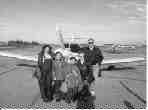After years of suffering, Estelle Cyr finally succumbed to primary pulmonary hypertension at age 27. She left behind three daughters, Melanie, Lynne and Angele. The three girls would go to live in Timmins, Ont., with their grandmother, Cecile LePage, who was 69 at the time.
Pulmonary hypertension is the progressive narrowing of blood vessels that eventually leads to heart failure. But with symptoms such as shortness of breath, fatigue, and light-headedness, the disease is often difficult to properly diagnose. Local doctors monitored the Cyr girls for symptoms of their mother’s condition but they couldn’t be sure. Three years later, it was determined that the girls should be looked at by doctors at the Hospital for Sick Children in Toronto.
There was just one problem: how to get them there?
The price of a commercial flight was out of Mrs. LePage’s reach, and driving was also out of the question as it’s a 12-hour drive in ideal conditions. The situation looked grim and it didn’t look like the girls would be examined.
Then it was suggested that they contact Hope Air, an organization that flies people who are ill and living in remote areas to healthcare facilities in big cities.
LePage called Hope Air and a short time later the three girls and their grandmother were being taxied to Toronto in a small aircraft by volunteer pilots. Shortly after their 2-hour flight the three young ladies were being examined by some of the best medical doctors in the country.
“The flying was definitely the best part,” says 14-year-old Melanie Cyr.
And what was the doctors’ diagnosis? None of the girls shared their mother’s affliction.
This was one of many good-news stories for Hope Air.
The organization was founded by two volunteers for the Canadian Cancer Society, Jinnie Bradshaw and Joan Rogers, in 1985, with start-up funding from the McLean Foundation. They were inspired by the vision of Corporate Angel Network, a charitable organization in the U.S. that had been providing air transportation for cancer patients since 1981. The women dubbed their brainchild Mission Air and the service was born. Beginning back in 1986 with 8 passengers flown, the organization currently provides over 3,000 flights per year. There are four full-time staff and a contingent of over 30 volunteers who provide administrative and client services. In October of 1999, the organization changed its name to Hope Air. During that year, Hope Air arranged 4,163 flights, valued at more than $2 million (based on average fares provided by the airlines and donated volunteer flights).
Hope Air relies heavily on commercial airlines: Air Canada is the organization’s biggest contributor. But they also have arrangements with Air BC, Air Creebec, Air Nova, Air Ontario, American Airlines, Bearskin Airways, Central Mountain Air, Canadian Airlines International, Canjet, Royal Airlines and Westjet Airlines. And when the big planes no longer service an area, the organization uses a network of volunteer pilots, who, until recently, paid for the trips entirely out of their pockets. (A new deal will Shell will give pilots a voucher covering half their fuel costs.)
“This program has only been around 15 months and it’s quite extraordinary. The pilots give us their time, they give us their planes. Up until now, the pilots paid for it themselves,” says Corrie Fraser, Hope Air’s executive director.
Mining giant Falconbridge was also a major sponsor until economic realties forced the nickel producer to back out. But that wasn’t the only connection to the industry. Terence McConnell, the director of business development for Scintrex, a Concord, Ont.-based Geophysical Surveying and Consulting firm, is the president of Hope Air. Hope Air’s volunteer representative on the board, Carol Ann Devine, is a former geologist and geochemist. And founder Joan Rogers is a member of Women’s Association of the Mining Industry of Canada. Hope Air also services many remote communities, many of which are mining related.
Hope Air has a 98% success rate — only 2% of those who contact Hope Air are refused help. Canadian citizens who cannot receive treatment locally are eligible for Hope Air flights. They must prove financial need, be referred by local doctors and have an appointment booked at a healthcare facility. There is also an administrative charge of $25.00. But Fraser stresses that it is not an emergency service.
The organization now needs more sponsors. Hope Air receives minimal funding from provincial governments and no funding from the federal government. The Ontario government donates $30,000 in exchange for Hope Air’s providing the province’s back-up organ retrieval system.
“I really appreciate what they did for me, [the girls] are all I have left,” explains LePage.
For more information visit the web site at www.hopeair.org or call 1-877-346-4673.


Be the first to comment on "Hope is in the air"